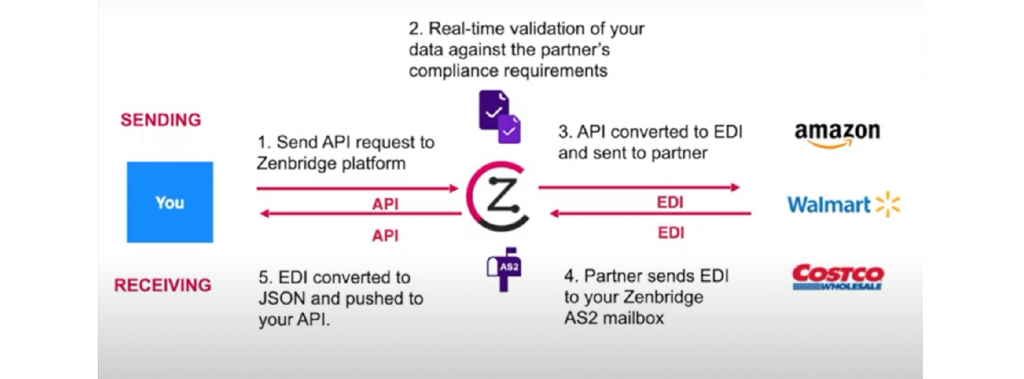EDIFACT EDI Integration Using API in 2025

If you are a modern-day API developer tasked with EDIFACT EDI Integration for your company, you might feel overwhelmed by the complexity of traditional EDI systems. It would be pretty much impossible without hiring or relying on EDIFACT EDI experts. Fortunately, EDI-as-API simplifies the EDIFACT integrations , enabling perfect B2B data exchange across industries.
Lets take a closer look on how to integrate EDIFACT using APIs and why it’s the ideal solution in 2025.
What is EDIFACT?
EDIFACT is the most popular EDI standard for B2B supply chain communications in Europe. It was developed by the United Nations to define rules and syntax for repetitive documents used in EDI. There are several versions of EDIFACT that emerged over time as more and more businesses narrowed or modified their EDI requirements. New EDIFACT specifications keep adding to the structure that defines how companies in different sectors interact with each other.
EDIFACT is used for the exchange of EDI in transport, manufacturing, logistics, etc, in sectors like retail, agriculture, and the public sector. Here are some commonly used EDIFACT documents:
| DELJIT | Delivery just-in-time message | specifies precise delivery sequence and just-in-time schedule requirements |
| DELFOR | Delivery schedule message | specifies short-term delivery or medium to long product schedule requirements |
| DESADV | Despatch advice message | specifies goods despatched or ready to dispatch on agreed conditions |
| INVOIC | Invoice message | specifies payment claims between sellers and buyers |
| INVRPT | Inventory report message | specifies information about held inventories between trading partners |
| ORDERS | Purchase order message | specifies the details for orders placed for goods or services |
| ORDCHG | Purchase order change request message | specifies the details from buyers to the seller to change a purchase order |
EDIFACT EDI integration using API
Why Choose EDI-as-API for EDIFACT Integration?
Traditional EDI software can be a real headache. It’s expensive, takes months to integrate and usually needs expertise just to keep things running, making it challenging for API developers.
That’s where EDI-as-API platforms come in—offering a smarter, more flexible way to connect systems. Here’s why more businesses are making the switch in 2025:
- Built for Modern Systems: Most tools you already use—like your ERP, WMS, or eCommerce platforms—are API-driven. So, it just makes sense to handle EDI the same way.
- Fast and affordable: Instead of spending months (and a small fortune) on traditional EDI, API-based platforms can get you up and running in days—without draining your budget.
- Developer-Friendly Tools: You don’t need to be an EDI expert. With familiar formats like JSON or XML, your existing developer team can handle integrations without any external help.
- Scalability: Platforms like Zenbridge support all EDIFACT versions and a wide range of industries, ensuring flexibility as your business grows.
Comparison: EDI-as-API vs. Traditional EDI
| Feature | EDI-as-API | Traditional EDI |
| Integration Time | Days | 3–9 Months |
| Cost | Affordable, subscription-based | High setup and maintenance |
| Developer Expertise | Requires no EDI specialists | Requires EDI specialists |
| Scalability | Supports all EDIFACT versions | Limited flexibility |
| Real-Time Validation | Yes | Often manual |
Introducing Zenbridge: The Leading EDI-as-API Platform
Introducing Zenbridge – The Leading EDI-as-API Platform
Zenbridge is a cutting-edge EDI-as-API platform designed to simplify EDIFACT integration. It enables developers to send and receive EDIFACT messages using APIs and webhooks, replacing complex Traditional EDI processes with simpler, faster, and automated workflows.
Core EDI API parser:
What we have at the core of the system is an EDI API parser that converts EDIFACT specifications and translates them into API -friendly JSON or XML models, supporting all documents and versions of EDIFACT across industries.
Setting up an EDIFACT integration project:
The first step in setting up an EDIFACT integration project in Zenbridge is, configuring your trading partner’s EDIFACT specifications in the platform. We have an online EDIFACT specification editor that lets you configure your trading partner’s EDIFACT specifications. If you are not familiar with what specifications are, they are nothing but the list of mandatory and optional data points that need to be exchanged in an EDIFACT EDI file. Of course, it is not just a list. Rather, the data payload is formatted according to the EDIFACT standard.
Once EDIFACT specifications are set up, they are published in real-time as API endpoints and API documentation. For example, if your trading partner is Schwarz, and you configure their Purchase order spec on the platform, the following API endpoint would be published.
api.zenbridge.io/schwarz/orders
Send EDIFACT data to your trading partner (JSON to EDIFACT)
To send an EDIFACT file to your trading partner, all you need to do is send a JSON request to the Zenbridge platform. Zenbridge validates your API request against the trading partner’s compliance requirements. If the data meets the compliance requirements of your trading partner, the EDIFACT EDI file is generated, and you will receive an HTTP 200 response. The platform will then send the EDIFACT message to your partner’s AS2 / SFTP mailbox.
If the data is non-compliant (violates the trading partner’s EDI specification), you will get an HTTP 400 error in the API displaying error messages. The validation takes real-time to ensure you always send compliant EDIFACT files to your trading partner. It saves you time and money that you would spend correcting non-compliant documents if you were using a legacy EDI service.

Receiving EDIFACT using API from your trading partner (EDIFACT to JSON)
Zenbridge creates an AS2 mailbox for you when you sign up on the platform. Your trading partners will use this AS2 connection to send EDIFACT files to you. Zenbridge will validate their EDIFACT files against your compliance requirements. If everything is fine, it will get converted into JSON and sent to your API’s callback URL.
You can set up Webhook/callback URLs with Zenbridge to view the received JSON files. You can also view all your EDIFACT transactions in Zenbridge’s Dashboard.
EDIFACT API – Conclusion
Till now there are no easy ways for the API developers to deal with the complexity of EDIFACT structure. Due to this reason the legacy EDIFACT services today take the same 3-9 months as they used to a decade ago. That’s something that bothers most of the customers who expect faster integration.
What we have done with Zenbridge is that we have opened up the world of EDI to modern-day developers. Today, Zenbridge is the only platform to support API for all EDIFACT EDI. Schedule a demo with us today to explore the EDIFACT EDI Integration using API.